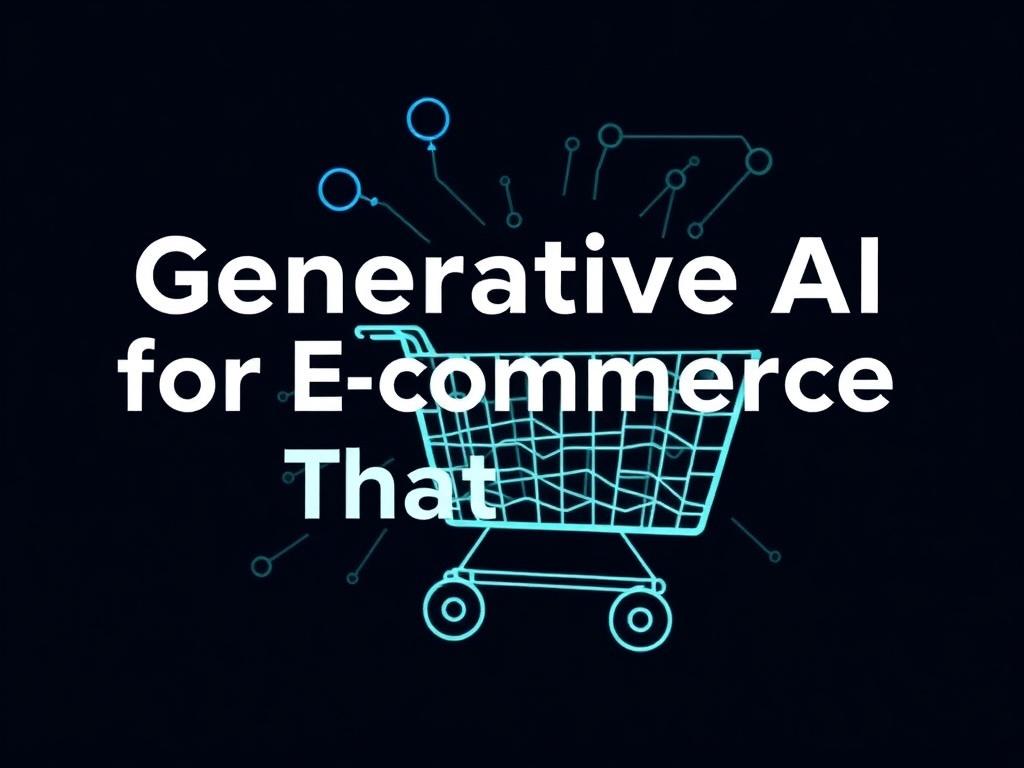Generative AI has moved from novelty to necessity in the fast-paced world of e-commerce. If you run an online store, you know that product descriptions are not just small blocks of text — they’re persuasion tools that influence search visibility, buyer trust, and conversion rates. Yet writing compelling, SEO-friendly, and scalable descriptions for thousands of SKUs is a huge time sink. That’s where generative AI comes in. In this article I’ll walk you through why generative AI matters for e-commerce, how to integrate it into your content workflow, practical prompt strategies, quality control methods, ethical and legal considerations, and measurable ways to test and scale. Whether you manage a boutique shop or a massive marketplace, you’ll get actionable guidance that helps you create product descriptions that actually sell.
Why Generative AI Is a Game Changer for Product Descriptions
E-commerce success rests on three elements: findability, credibility, and relevance. Product descriptions influence all three. Traditionally, merchants either wrote descriptions manually, which doesn’t scale, or copied manufacturer text, which often underperforms in search and conversion. Generative AI flips that tradeoff by offering speed, variation, and the ability to tailor content for SEO, voice, and audience segments.
Generative AI models can create descriptions that blend benefits, features, and storytelling in a consistent brand voice. They can produce many variations quickly, which is great for A/B testing and personalization. But speed alone isn’t enough. The real value comes when AI-generated content is guided by smart prompts, product data, and human oversight. That combination yields descriptions that are accurate, persuasive, and optimized for search engines.
Beyond production, generative AI helps with multilingual content, localization, image captions, and bundled product narratives — tasks that used to require multiple specialists. For merchants with seasonal SKUs or large catalogs, this reduces cost and time-to-market without sacrificing quality.
Key benefits at a glance
Here are the most important advantages you’ll get when you use generative AI thoughtfully:
- Scalability: Produce thousands of descriptions in hours rather than weeks.
- Consistency: Maintain brand voice across categories and teams.
- Speed: Faster time from product arrival to live listing.
- Personalization: Tailor descriptions for customer segments, regions, and channels.
- SEO optimization: Integrate keywords and structured data automatically.
- Cost-efficiency: Lower content creation costs compared to hiring large copy teams.
How Generative AI Fits into an E-commerce Content Workflow
You don’t drop a generative model into your stack and expect perfection. Think of AI as a teammate that needs good inputs and human supervision. The workflow typically involves four stages: data ingestion, prompt design, generation, and review & optimization. Each stage has its own best practices.
1. Data ingestion: feed the model what it needs
The model performs best when it has structured product data: title, brand, category, features, dimensions, materials, target audience, price, and unique selling points. The more accurate and granular your product attributes, the more specific and useful the AI output will be. Enrich product feeds with high-quality images and tags so the AI can create contextually relevant descriptions.
Gather source material in a single place — your PIM (product information management system), ERP, or a CSV export from your storefront. Clean the data: fix missing fields, standardize units, and confirm brand claims. Bad input leads to bad output, and fixing that downstream is time-consuming.
2. Prompt design: craft the instruction that drives results
Prompt engineering is the art of telling the AI exactly what you want. A good prompt includes the product data, the tone of voice, target keywords, length constraints, and where the content will be used (e.g., product page, social ad, email subject). Using templates for prompts ensures reproducibility across thousands of products.
Here’s what an effective prompt includes:
- Product title and attributes.
- One-sentence brand voice instruction (e.g., friendly, professional, playful).
- Audience note (e.g., busy parents, outdoor enthusiasts).
- SEO keywords or phrases to include.
- Required facts that must appear (e.g., «water-resistant to 50 meters»).
- Length (word count or character limit) and format (bullet points, short paragraph, features list).
3. Generation: use AI to produce drafts and variations
With good prompts and clean data, you can generate multiple versions of each product description in seconds. Use generative AI to create:
- Short product blurbs for collection pages.
- Long, persuasive descriptions for product detail pages.
- Bulleted feature lists for quick scannability.
- SEO meta descriptions and alt text for images.
- Localized versions in different languages.
It’s wise to generate several variations and keep the best ones. Variation helps with A/B testing and allows marketplaces to rotate descriptions for performance optimization.
4. Review and optimization: human-in-the-loop
Never publish AI output without review. Editors should check facts, correct tone, ensure legal compliance (no false claims), and optimize for readability and conversion. Use checklists and QA tools to spot common issues like hallucinated features, inconsistent sizing, or brand violations. Integrate analytics so you can iterate based on real performance metrics.
Prompt Templates and Examples
Prompts are the backbone of good AI output. Below is a table with versatile prompt templates you can adapt to your catalog. Each template shows what to include and what kind of output to expect.
| Template Type | Prompt Elements | Expected Output |
|---|---|---|
| Short Listing | Product name, 2–3 key features, tone = concise, length = 50–80 chars | One-line blurb for collection pages |
| Full Description | Product attributes, target audience, benefits, SEO keyword, tone = friendly, length = 120–200 words | Persuasive paragraph with features and CTA |
| Bullet Features | List of technical specs, formatting = 5 bullets, each 8–12 words | Scannable feature list |
| Meta Description | Product name, unique benefit, SEO keyword, length = 150–160 chars | Search-engine meta description |
| Localized Copy | Original description, locale, cultural tone, language specifics | Natural localized copy |
Example prompt and result
Here’s a real-world example you can copy and adapt:
Prompt: «Write a 150-word product description for the ‘AeroLight Running Jacket’ targeted at weekend runners. Include four features — breathable fabric, water-resistant finish, reflective trim, and zippered pocket. Tone: encouraging and practical. SEO keyword: ‘running jacket for women’. End with a short call-to-action.»
The AI should produce a concise, benefit-driven paragraph that naturally includes the keyword and features, speaks to the audience, and ends with a CTA. Use variations of this template to generate A/B testing options.
Writing Styles and Conversion Psychology
Product descriptions must do two things: answer the buyer’s questions and nudge them toward purchase. Good writing achieves credibility and emotion in balance. Generative AI can emulate different psychological triggers: scarcity, social proof, authority, curiosity, and benefit orientation. Use these triggers responsibly.
Persuasion frameworks to use
- FAB (Features → Advantages → Benefits): Start with features but always translate them into user benefits.
- Before–After–Bridge: Show life before the product, life after, then explain how the product bridges the two.
- Problem–Agitate–Solve: Highlight the problem, make the pain real, then present the product as the remedy.
Generative AI can be told which framework to use. For example: «Write a product description using FAB format and emphasize emotional benefits.»
Tone and voice
Define a handful of brand voices for different categories. For instance, a tech accessory might use «confident and precise» while home goods might use «warm and approachable.» Keep the voice consistent in prompts. A table below shows voice examples and when to use them.
| Voice | When to Use | Style Notes |
|---|---|---|
| Confident & Technical | Electronics, tools | Use precise terms, include specs, avoid hyperbole |
| Warm & Inviting | Home, lifestyle | Use sensory language and cozy imagery |
| Playful & Casual | Apparel for young audiences | Use colloquial phrasing and short, fun sentences |
| Professional & Trustworthy | Health, finance adjacent products | Stick to facts, use measured claims and citations |
SEO, Keywords, and Structured Data
Generative AI can help satisfy both users and search engines when used with an SEO strategy. Remember that SEO is about intent and usefulness, not clever keyword stuffing. Use generative AI to naturally incorporate target keywords and generate supporting content like FAQs, schema markup, and meta descriptions.
Use generative AI to create supporting SEO assets
- Product-oriented FAQs that answer buyer questions and target long-tail queries.
- Schema.org product markup snippets (JSON-LD) that improve SERP display.
- Related blog blurbs or buying guides that attract informational queries.
- Meta descriptions and title tag suggestions tailored to keyword priorities.
Best SEO practices to include in prompts
When prompting the AI, specify:
- Primary and secondary keywords and natural ways to include them.
- Avoiding duplicate content — ask for unique wording if manufacturer text exists elsewhere.
- Desired heading structure and inclusion of H2-style FAQ headings.
Personalization and Segmentation
Personalization can significantly boost conversion rates. Generative AI excels at producing variants targeted for different buyer personas, channels, or stages of the funnel.
Examples of targeted variations
- For bargain-seekers: emphasize value, discounts, and multi-pack savings.
- For feature-driven shoppers: highlight technical specs and performance metrics.
- For eco-conscious consumers: mention sustainable materials and certifications.
- For gift shoppers: focus on unboxing, presentation, and occasion appropriateness.
Implementing personalization at scale
At scale, you’ll generate multiple templates per product based on persona variables. Store these in your CMS and serve the best variant using rules tied to user segments and cookies. For example, visitors arriving from a sustainability article might see a description that foregrounds green credentials.
Quality Control: Human-in-the-Loop and Automated Checks

Automated tools accelerate production; humans maintain quality. Combine both.
Automated checks to run on AI output
- Fact validation against your product data feed (sizes, specs).
- Plagiarism detection and duplicate content checks.
- Brand compliance: banned words, pricing promises, legal phrases.
- SEO checks: keyword inclusion, meta length, readability scores.
Human review checklist
- Verify no invented features or claims — cross-check with manufacturer specs.
- Check tone and brand voice consistency.
- Ensure measurements and units are accurate and consistent.
- Confirm any warranty or regulatory statements are correct and approved.
- Approve final copy and record versioned edits for audits.
Testing and Metrics: How to Know When AI Works
Don’t assume AI-generated content is better. Test it. Use a structured approach to measure impact.
Key metrics to track
- Conversion rate lift on product pages (sessions → purchases).
- Bounce and exit rates from product pages.
- Time on page and scroll depth (engagement signals).
- Organic search ranking and impressions for product pages.
- Click-through rates from category pages and paid ads.
A/B testing framework
Run controlled experiments:
- Variant A: existing (handwritten/manufacturer) copy.
- Variant B: AI-generated version.
- Measure over a representative period and traffic volume.
- Segment by device, channel, and user intent to understand differential impacts.
If Variant B performs better, you can gradually roll it out. Keep iterating so AI benefits compound over time.
Ethical, Legal, and Brand Safety Considerations

AI can produce compelling language, but it can also invent facts or reframe sensitive topics incorrectly. Address these risks systematically.
Legal and compliance checklist
- Ensure product claims (health, safety, environmental) are substantiated and legally approved.
- Avoid comparative statements that may invite legal disputes unless verified.
- Maintain records of AI outputs and human approvals for audit trails.
- Respect trademarks and vendor agreements — don’t make false associations.
Ethical considerations
Be transparent internally about AI usage. If your product content impacts safety or health decisions, adopt stricter review protocols. Bias can creep in — monitor descriptions for gendered language or stereotyping and correct it proactively.
Tooling and Integration Options
Generative AI can be used via APIs, off-the-shelf platforms, or integrated into your PIM/CMS. Choose tools that match your technical capacity and governance needs.
Common integration patterns
- API-first approach: Use an LLM API to generate content inside a staging environment; editors review before publishing.
- Plug-in approach: Use SaaS platforms that connect to Shopify, Magento, or BigCommerce with built-in prompts and workflows.
- Hybrid: Use a headless CMS where content is generated via API and then managed by editors in the CMS UI.
Selection criteria for tools
Consider:
- Data security and compliance (especially for PII or proprietary product data).
- Support for fine-tuning or custom prompt templates.
- Cost per token/character and scalability.
- Auditability — tracking prompts, outputs, and approvals.
Common Pitfalls and How to Avoid Them

Generative AI can introduce new problems if used carelessly. Here are common pitfalls and countermeasures.
Pitfall: Hallucinated facts
Countermeasure: Always validate generated facts against your product feed; block publication until verified.
Pitfall: Duplicate or manufacturer text
Countermeasure: Ask the AI to rewrite in a unique voice and run duplication checks. Maintain a database of source texts to compare.
Pitfall: Inconsistent sizing or units
Countermeasure: Standardize units in source data and force the AI to use those units via the prompt.
Pitfall: Over-optimization for SEO
Countermeasure: Prioritize user clarity and usefulness. Use keywords naturally and avoid stuffing.
Scaling: From Pilot to Production
Start small. Choose a representative subset of your catalog (e.g., a single category with varied SKUs) to pilot. Measure results, refine prompts, and build automation for approvals and publishing.
Steps to scale
- Run a pilot on 100–500 SKUs to validate ROI and QA processes.
- Create centralized prompt templates and voice guides.
- Automate data validation steps and plagiarism checks.
- Implement version control and approval workflows in your CMS.
- Train editors on AI workflows and how to spot errors.
- Roll out incrementally by category and monitor performance.
Case Studies and Real-World Examples
Many companies are already seeing benefits. Below are hypothetical but realistic examples that illustrate common outcomes.
Example 1: Mid-sized apparel brand
A 500-SKU apparel brand used generative AI to create size-aware descriptions and lifestyle blurbs. They generated three variants per product and ran A/B tests. Results: a 12% lift in conversion rate on product pages after human editing reduced ambiguous size claims.
Example 2: Marketplace with thousands of SKUs
A large marketplace automated meta descriptions, alt text, and short blurbs across 50,000 listings. This improved organic search impressions by 18% and reduced the time-to-list by 70%, allowing the marketplace to onboard vendors faster.
Example 3: Electronics retailer
An electronics retailer combined AI with spec validation to generate technical descriptions and FAQ sections. They saw a 9% reduction in product returns because clearer descriptions reduced buyer confusion.
Practical Prompt Library You Can Use Today
Below are several ready-to-use prompts. Swap in your product fields and brand voice.
| Prompt Purpose | Example Prompt |
|---|---|
| Short listing | Write a 60-character product blurb for {product_name}. Include {one_key_benefit} and keep tone {brand_tone}. |
| Full description | Write a 150-word product description for {product_name} targeted at {audience}. Include features: {feature_list}. Tone: {brand_tone}. SEO keyword: {keyword}. |
| Bulleted features | Convert these specs into five concise bullets: {specs}. Each line should be 8–12 words and highlight benefits. |
| FAQ | Generate 4 buyer FAQs for {product_name} with brief answers of 20–40 words each. Cover shipping, sizing, care, returns. |
Cost Considerations and ROI
Costs depend on the tool, generation volume, editing overhead, and engineering integration. Calculate ROI by comparing time saved and conversion lift against subscription/API costs and editorial hours.
Rough cost model
- Tool/API: variable, often per 1,000 tokens or per request.
- Engineering: one-time integration and ongoing maintenance.
- Editorial: editing time per SKU (will decline as templates improve).
- Quality assurance: automated checks and human reviewers.
If AI reduces editing time per SKU by even 30–50% while increasing conversion by a few percentage points, you often see positive ROI quickly.
Future Trends to Watch
Generative AI will keep improving, and several trends will shape e-commerce content next:
- Multimodal generation: combining image analysis with text generation to create descriptions based on product photos.
- Real-time personalization: content that adapts live to user behavior and purchase history.
- Deeper fine-tuning: brands training models on proprietary style guides for unique voices.
- AI-assisted A/B testing: continuous content optimization via automated test generation and rollout.
Stay adaptable and focus on building systems that can incorporate new capabilities as they arrive.
Checklist: Getting Started This Week
If you want to start implementing generative AI for product descriptions right away, follow this practical checklist.
- Identify a pilot category of 100–500 SKUs.
- Export product data and clean missing fields.
- Choose an AI tool with API access and acceptable data security.
- Create 3–5 prompt templates: short blurb, full description, features, and meta.
- Generate variations and create a review workflow for editors.
- Run A/B tests and track conversion, bounce rate, and SEO metrics.
- Iterate on prompts and scale after validating ROI.
Common quick wins
If you need immediate impact, prioritize these actions:
- Rewrite category pages and meta descriptions — often low-effort, high-impact for SEO.
- Generate short product summaries for collection tiles to improve CTR.
- Create FAQs for top-returned items to reduce post-purchase confusion.
- Automate image alt text to improve accessibility and organic visibility.
When to slow down or pause
If your product involves regulated claims, safety-critical information, or legal obligations (e.g., medical devices, consumables, children’s safety gear), add extra verification steps and consider slowing automation until protocols are ironed out.
People and Process: Building a Sustainable Team
Tools matter, but people and processes make outcomes reliable. You’ll need:
- Content strategists to define voice and frameworks.
- Prompt engineers (could be trained editors) who create and refine templates.
- Product data specialists who ensure feed quality.
- Editors and QA reviewers who approve outputs.
- Analytics and SEO specialists to measure impact and recommend optimizations.
Define SLAs, version control, and approval gates. The goal is to make AI a productivity multiplier, not a source of risk.
Final tips and best practices
- Start with structure: clean product data before generating content.
- Be explicit in prompts — the AI needs clear constraints.
- Generate multiple variants and keep what performs best.
- Maintain human oversight for legal and factual accuracy.
- Measure everything — conversions, returns, search rankings, and editorial time saved.
- Iterate: prompt engineering is an ongoing activity, not a one-time setup.
Conclusion
Generative AI offers a pragmatic way to scale high-quality product descriptions while improving SEO and conversion — but it’s not a plug-and-play miracle. Success requires clean product data, disciplined prompt design, human oversight, and iterative testing. Start small, build robust workflows, and measure impact so you can expand confidently. When done right, generative AI frees teams to focus on higher-level strategy and storytelling, turning product descriptions from a chore into a competitive advantage that truly helps your customers buy.
